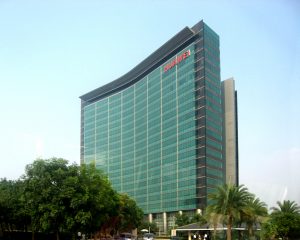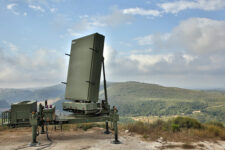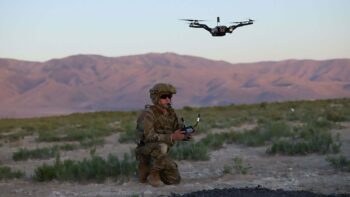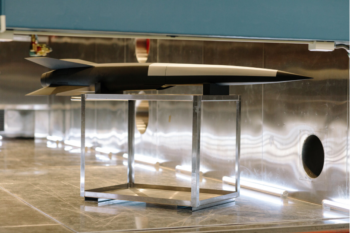 WASHINGTON: The United States needs to take a stronger role in setting international standards for 5G networks or risk losing the international market to China and undercutting US national security.
WASHINGTON: The United States needs to take a stronger role in setting international standards for 5G networks or risk losing the international market to China and undercutting US national security.
Washington is faltering due to a lack of coherent policy on a wide swathe of foundational issues such as spectrum management for 5G usage, network supply chain security, infrastructure development and data sharing, experts say.
As Breaking D readers know, the question of spectrum access is at the heart of DoD’s fierce battle to overturn the FCC’s approval last month of a plan by Ligado to convert L-band spectrum for satellites to build a terrestrial 5G mobile communications network that DoD and many other US agencies say will jam GPS receivers.
“The US-China competition is essentially about who will control the global information technology infrastructure and standards,” said Frank Rose, a senior fellow at Brookings Institution and former assistant secretary of State for arms control, during a Brooking’s webinar on Friday. “I think an argument can be made that in the 21st century, whoever controls the information infrastructure will dominate the world.”
The webinar, called “Global China: Assessing China’s technological reach in the world,” was based on a new series of Brookings’ papers on topics ranging from Chinese plans for 5G, its progress in developing artificial intelligence (AI) weapons systems to biotechnology.
The panel discussion echoed the concerns raised by a group of powerful Republican senators in an April 14 letter to Commerce Secretary Wilbur Ross, Energy Secretary Dan Brouillette, Defense Secretary Mark Esper, and Secretary of State Mike Pompeo. Led by Senate Armed Services Committee Chairman James Inhofe, the senators worried that the Trump administration’s moves to blacklist Chinese 5G behemoth Huawei (about which Sydney has written extensively) are in effect pushing the US into international irrelevance as Washington struggles to set a unique domestic path for network development.
Commerce put Huawei on its so-called entity list last May citing national security concerns, and in August expanded its list of related entities subject to restricted US sales. Despite President Donald Trump’s wild swings on whether to keep or lift the ban, those restrictions still stand.
“Since Huawei’s designation on the Department’s Entity List in May 2019, U.S. technology leaders have been constrained from full participation in 5G standards-setting bodies because of uncertainty over whether such participation is prohibited by the Commerce Department’s export control regulations. We are deeply concerned about the risks to the U.S. global leadership position in 5G wireless technology as a result of this reduced participation, and the economic and national security implications of any diminished U.S. role in 5G,” the senators wrote.

Huawei HQ in Shenzhen, China
Such standards bodies include the influential private-sector Institute of Electrical and Electronics Engineers, the widely-recognized International Standards Organisation (ISO) and the UN’s International Telecommunication Union (ITU) that sets global standards for spectrum usage. China’s Houlin Zhao currently holds the ITU Secretary-General post, and China has been extremely active in ITU work to establish standards for 5G — an issue that the U.S.-China Economic and Security Review Commission raised in its 2018 report to Congress.
To remedy this, the senators called on the White House “to issue regulations as soon as possible confirming that U.S. participation in 5G standards-setting is not restricted by export control regulations.” And according to a May 6 article by Reuters, the Commerce Department is currently figuring out how exactly to do just that. Commerce, however, did not respond to a request for comment by press time.
Nicol Turner Lee, a Brookings fellow specializing in Internet governance issues, told the panel while it was Europe that set the standards for 3G communications technologies, the US learned from losing that battle and so “stepped up” to lead the world in developing the technologies and standards for 4G LTE communication. US leadership on 4G in turn allowed it dominate the information revolution that underpins today’s “digital sharing economy,” enabling tech giants Google and disruptive firms such as Uber.
But the US now risks losing the 5G race to China, she argued, which will be at the heart of the next technological revolution. Mobile 5G cellular networks will provide the high speed and low latency (the time between data being broadcast and received by a user) communications capabilities required by the Internet of Things (IoT) and AI, both technologies hotly pursued by the US the Chinese militaries alike.
In her paper, “Navigating the U.S.-China 5G Competition,” Turner Lee explained:
“The United States and China are in a race to deploy fifth-generation, or 5G, wireless networks, and the country that dominates will lead in standard-setting, patents, and the global supply chain. While some analysts suggest that the Chinese government appears to be on a sprint to achieve nationwide 5G, U.S. government leaders and the private sector have been slowed by local and federal bureaucracies, restrictive and outdated regulations, and scarcity of available commercial spectrum.”
The “current national security concerns of Huawei and ZTE, which are integral to the global supply chain for 5G equipment and software” not only are hindering the ability of US tech firms to play a leading role in international standard setting bodies, she said, but also cramping their ability to cooperate with firms in allied nations — leading to US market isolation.
“To date, only five other partners have followed the U.S. lead in banning Huawei equipment in their communications infrastructures: Japan, Taiwan, Vietnam, Australia and New Zealand.25 Other U.S. allies, including France, Germany, Italy, the Netherlands, and the U.K., are moving forward with their deployments with some restrictions,” Turner Lee wrote.
Key to China’s success in development of 5G networks has been the use of low- and mid-band radio frequency (RF) spectrum, according to experts, that for reasons of domestic regulation the US has been unable to match.
Meanwhile, the US has been “spectrum stuck” — unable to move rapidly to figure out how different RF user communities — including military and commercial satellite operators and US military radar systems — can share the limited resources.
Low-band spectrum, which includes the 600 megahertz (MHz), 800 MHz, and 900 MHZ bands, can cover longer distances and penetrate through walls of buildings. Mid-band spectrum is in the 2.0 gighertz (GHz) 6 GHz range, works at a higher speed and in some instances provides higher fidelity.
Indeed, the mid-band includes portions of the L-band spectrum, in the 1 GHz to 2 GHz range, at the heart of DoD’s battle with the Federal Communications Commission over Ligado. L-band signals, used by GPS, are less likely to be degraded by clouds, fog and rain and can pass through heavy foliage.
DoD, the Federal Aviation Administration, the Department of Transportation — and a wide range of private sector companies ranging from satellite operators to truckers — are convinced that Ligado’s planned network will jam GPS receivers.They are supported by a number of powerful members of Congress, including Inhofe and SASC Ranking Member Sen. Jack Reed, as well as the leadership of the House Armed Services Committee.
House Armed Services Committee Chairman Adam Smith and Ranking Member Mac Thornberry, together with 20 other members representing both political parties, weighed in last Thursday in a letter to the FCC Commissioners questioning the Ligado decision and expressing concern:
“Section 1698 of the National Defense Authorization Act for Fiscal Year 2017 prevents the commission from approving commercial terrestrial operations in these bands until 90 days after the commission resolves concerns of widespread harmful interference by such operations to covered GPS devices. We are concerned that your approval of any mitigation efforts not rigorously tested and approved by national security technical experts may be inconsistent with the legislative direction to resolve concerns prior to permitting commercial terrestrial operations. We urge the commission to reconsider and impose additional mitigation steps to address the concerns of these users.”
HASC intends to hold a classified hearing to focus on the issue, including both DoD and the FCC.
However, the Trump administration is divided on the worthiness of Ligado’s plan — with the spat pitting Esper and Transportation Secretary Elaine Chao against Pompeo, National Economic Council Director Larry Kudlow, and Attorney General William Barr.
Kudlow, Pompeo and Barr, who all are close Trump political allies, have praised the FCC’s decision to approve Ligado’s network — along with many in the terrestrial wireless industry — as a move towards helping the US gain primary over China in the 5G race. And the need for the US to move out quickly to establish 5G networks figures prominently in Ligado’s various FCC filings.
In a marathon SASC hearing last Wednesday, DoD CIO Dana Deasy and Research and Engineering head Mike Griffin strongly pushed back against that assessment.
Griffin told the SASC that “5G is about capacity, latency, and scale. The Ligado proposal has absolutely nothing to do with latency and scale, and its capacity is on the order of three-and-a-half percent of the total spectrum capacity. Ligado’s existence, plus or minus, makes absolutely no difference to the involvement of the US in the so-called 5G race,” he said bluntly.
Deasy chimed in to back up Griffin, telling the SASC that “Ligado does not provide a 5G solution.” He explained that “the band in which Ligado operates is not even part of the FCC’s 5G FAST Plan, which is the commission’s blueprint for advancing US interest in 5G. The non-continuous bands that Ligado could bring the market are both fragmented and impaired.”
FCC Chairman Ajit Pai last April approved the FAST Plan — for “Facilitate America’s Superiority in 5G Technology — to free up some designated low-band, mid-band, and high-band spectrum now assigned to other uses use by 5G networks, as well as some spectrum currently unlicensed. That effort, however, has been complicated by squabbling among various operator communities.
Deasy stressed that DoD “clearly recognizes the huge value of 5G not only for commercial use, but across the US military as well.” And for that reason, he said, DoD not only has a plethora of 5G projects underway, but also has launched a pilot project on how best to share mid-band spectrum being used by DoD radar systems with commercial 5G networks. DoD is partnering on the pilot with the National Spectrum Consortium, he said, which involves government, industry and academia.
“The geopolitical battle is standard setting,” Turner Lee summed up during the Brookings’ webinar. “We need some coherency around what we’re actually doing on the public policy front, and we need some more technical coordination … so we could at least be at the stage where we’re still on the field, versus sitting on the sidelines trying to figure out how to catch up.”
AeroVironment purchases BlueHalo to ‘redefine the next era’ of defense technology
“The structure of the global defense sector is changing, and this transaction underscores that transformation,” said analyst Byron Callan of the merger.
















![E-2D_AR_1[1]](https://breakingdefense.com/wp-content/uploads/sites/3/2024/10/E-2D_AR_11-350x233.png)










